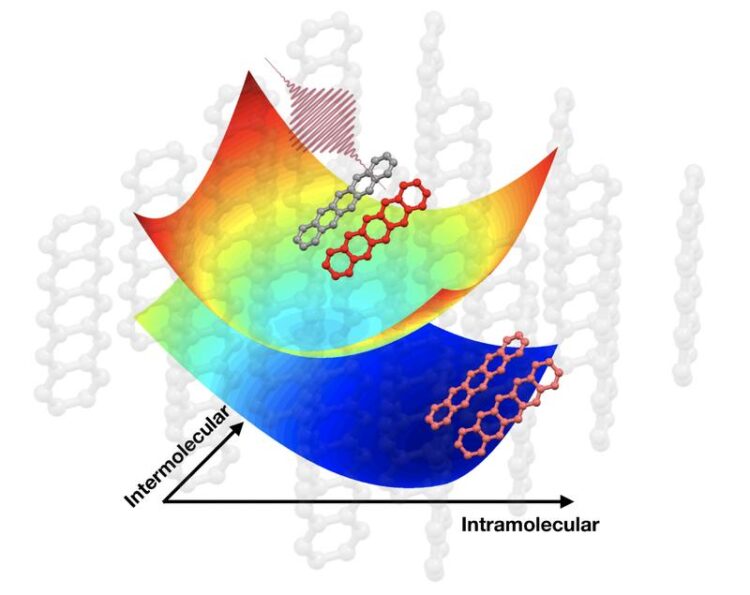Intermolecular rocking vibrations open up channels for ultrafast singlet fission

Quantum vibrational coherences drive ultrafast singlet fission
Hong-Guang Duan
The search for new, more efficient materials to harvest solar energy is a major research focus around the world. Until now, silicon has been the material of choice for solar cells – but scientists are trying to develop far more efficient and cost-effective alternatives. One promising material is pentacene, an organic molecule which converts solar energy extremely well when combined with certain other molecules. Pentacene stands out because of its ultrafast ‘singlet fission’ – a process which scientists hope to harness for the design of far more powerful solar cells. Now an international research team led by scientists from the MPSD has discovered why this process works so well in pentacene.
Their research shows that, once pentacene has absorbed light, its molecules develop rocking motions and specific vibrations which play a crucial role in converting the light into electrical energy in solar cells.
The work has just been published in Science Advances. The researchers came from the MPSD and the University of Hamburg (both in Germany), Stanford University and SLAC National Accelerator in the USA, the University of Oxford (UK), the TIFR Centre for Interdisciplinary Sciences (India), Peking University in China and the University of Toronto (Canada). The Hamburg research team involved scientists from the Cluster of Excellence CUI : Advanced Imaging of Matter and the Center for Free-Electron Laser Science (CFEL).
Each natural and synthetic system that converts the sun’s energy – from leaves on a tree to photovoltaic cells – does so through ultrafast processes at the atomic and molecular level. These processes involve the correlated evolution of these molecules’ vibrational and electronic degrees of freedom. Despite the astonishing progress in ultrafast optical spectroscopy, the accompanying structural changes during these processes are still not fully understood.
To explore these changes in the tiniest detail, the research team around Hong-Guang Duan and Ajay Jha from the MPSD investigated how pentacene molecules behave during the singlet fission process. They focused on the changes in the molecule during the generation of so-called triplet-pair state: the intermediate phase between the absorption of sunlight and the formation of product state, which finally leads to charges. This phase occurs in a few hundred femtoseconds, a femtosecond being a millionth of a billionth of a second.
To study this unimaginably fast process, the team used TG spectroscopy, an ultra-sensitive technique involving a pair of laser pulses which stimulate the material and a second pair of pulses which show the precise changes of the molecule on these ultrashort timescales.
Specifically, the researchers uncovered that vibrations of the pentacene molecules play a crucial role in the emergence of the triplet-pair state. The molecules perform a rocking motion, both individually and collectively. The scientists were able to chart the particular vibrational dynamics in the pentacene molecule during the important primary step of the singlet fission process.
These motions play a key role in the ultrafast singlet fission process in this material. Scientists trying to design new photoactive materials which mimic pentacene can now draw on these newly-discovered mechanisms to develop more efficient alternatives using the singlet fission process. The team’s work paves the way towards the next generation of solar energy harvesting systems with the efficient utilization of intermolecular vibrations as one of the design principles.
Wissenschaftliche Ansprechpartner:
Hong-Guang Duan, lead author: hong-guang.duan@mpsd.mpg.de
Originalpublikation:
https://advances.sciencemag.org/content/6/38/eabb0052
Weitere Informationen:
Media Contact
All latest news from the category: Power and Electrical Engineering
This topic covers issues related to energy generation, conversion, transportation and consumption and how the industry is addressing the challenge of energy efficiency in general.
innovations-report provides in-depth and informative reports and articles on subjects ranging from wind energy, fuel cell technology, solar energy, geothermal energy, petroleum, gas, nuclear engineering, alternative energy and energy efficiency to fusion, hydrogen and superconductor technologies.
Newest articles

Parallel Paths: Understanding Malaria Resistance in Chimpanzees and Humans
The closest relatives of humans adapt genetically to habitats and infections Survival of the Fittest: Genetic Adaptations Uncovered in Chimpanzees Görlitz, 10.01.2025. Chimpanzees have genetic adaptations that help them survive…

You are What You Eat—Stanford Study Links Fiber to Anti-Cancer Gene Modulation
The Fiber Gap: A Growing Concern in American Diets Fiber is well known to be an important part of a healthy diet, yet less than 10% of Americans eat the minimum recommended…

Trust Your Gut—RNA-Protein Discovery for Better Immunity
HIRI researchers uncover control mechanisms of polysaccharide utilization in Bacteroides thetaiotaomicron. Researchers at the Helmholtz Institute for RNA-based Infection Research (HIRI) and the Julius-Maximilians-Universität (JMU) in Würzburg have identified a…



